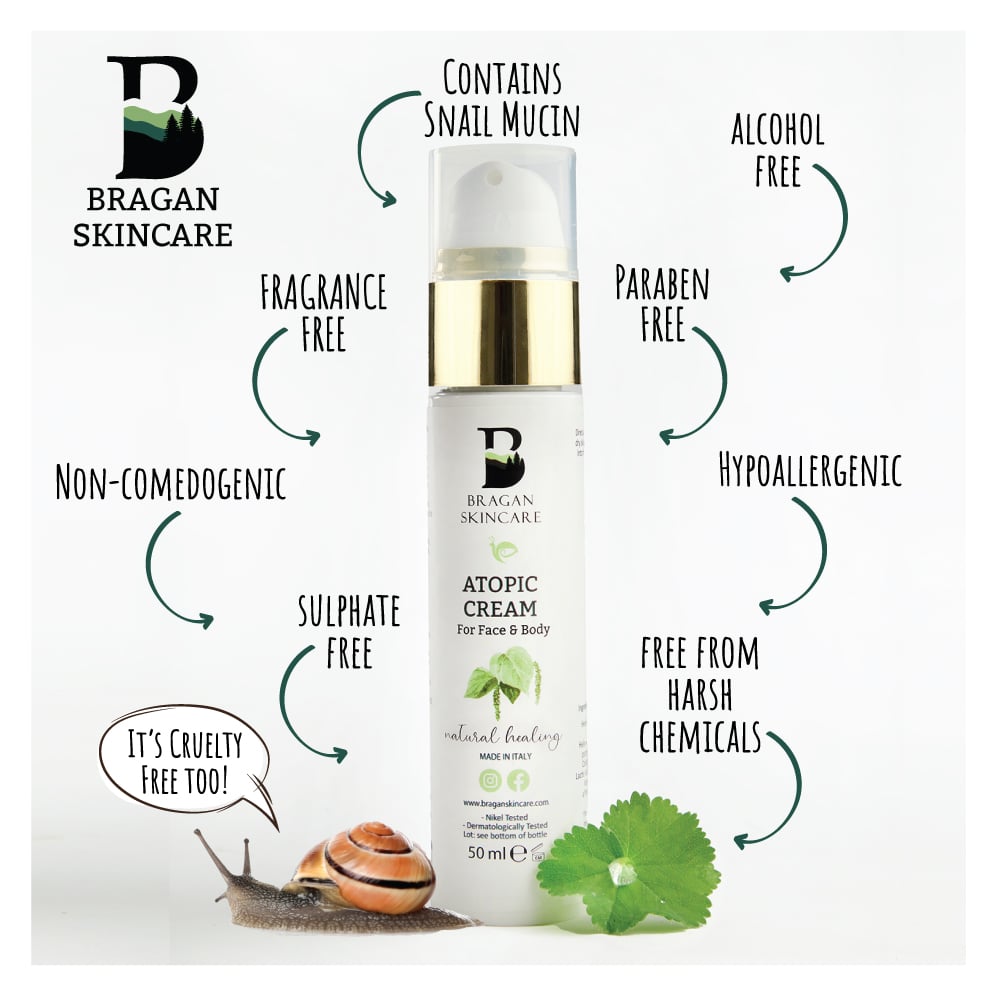Eyelid Eczema: Causes and Treatments.
Eyelid Eczema: Causes, Treatments, and Relief with Bragan Skincare’s Atopic Cream
Eyelid eczema can be a real nuisance. The skin around the eyes is delicate. When it becomes dry, red, or itchy, it’s hard to ignore. Everyday tasks like blinking, applying makeup, or washing your face can become uncomfortable. But you’re not alone. Many people suffer from eyelid eczema. And thankfully, help is available.
In this blog, we’ll explain what eyelid eczema is, what causes it, how to treat it, and how Bragan Skincare’s Atopic Cream has helped thousands of people find relief.

What is Eyelid Eczema?
Eyelid eczema is a type of skin inflammation. It affects the upper eyelid, lower eyelid, or both. The skin may appear dry, flaky, swollen, or red. It can feel itchy or tight. Sometimes, the skin may even crack or weep.
Because the skin on the eyelids is very thin, it is more likely to react to irritants. That’s why it’s a common place for eczema flare-ups.
What Causes Eyelid Eczema?
There are many causes of eyelid eczema. In fact, it can be tricky to pinpoint just one. However, the most common causes include:
1. Allergic Reactions
Some people develop eczema from allergens. These may include:
- Dust mites
- Pollen
- Pet dander
- Certain foods
Even skincare products, shampoos, or makeup can trigger a reaction. If you’re allergic to an ingredient, your skin will often react after contact.
2. Contact Dermatitis
This happens when the skin reacts to something it touches. Harsh soaps, perfumes, eye creams, or even nail polish can cause a flare-up. Often, the reaction is delayed. So, you might not notice it until hours later.
3. Atopic Dermatitis
This is a long-term type of eczema. It often runs in families. People with asthma or hay fever are more likely to have it. It can flare up due to stress, dry weather, or irritating substances.
4. Environmental Triggers
Cold weather, dry air, pollution, or too much sun can irritate the skin. These environmental changes can weaken the skin barrier and lead to inflammation.
What Does Eyelid Eczema Look Like?
If you’re unsure whether you have eyelid eczema, look out for these signs:
- Redness around the eyes
- Itchy eyelids
- Dry or scaly patches
- Swelling
- Cracked or thickened skin
- A burning or stinging feeling
Sometimes, eczema can be mistaken for an eye infection or allergy. That’s why it’s a good idea to talk to a doctor if you’re unsure.
Can Eyelid Eczema Be Cured?
There’s no permanent cure for eczema. But don’t worry. You can manage it and prevent flare-ups. With the right treatment and skincare routine, you can keep your skin calm, hydrated, and itch-free.
How to Treat Eyelid Eczema
Treating eyelid eczema starts with care. Here’s how:
1. Avoid Triggers
First, try to find what’s causing the flare-ups. Stop using products with fragrance or alcohol. Switch to hypoallergenic makeup. Use soft, clean towels on your face. Keep pets and dust away from your pillow.
2. Keep the Skin Moisturised
Dry skin makes eczema worse. So, keeping your eyelids well-moisturised is key. Use gentle creams that are free from harsh ingredients. Look for ones that are fragrance-free, paraben-free, and made for sensitive skin.
3. Use Soothing Creams
Sometimes, your skin needs a little help to heal. That’s where Bragan Skincare’s Atopic Cream comes in.

Why Bragan Skincare’s Atopic Cream Works So Well
Atopic Cream from Bragan Skincare was made with sensitive skin in mind. It’s gentle, nourishing, and completely free from irritants.
But what really sets it apart is one powerful ingredient: snail mucin.
You might be thinking – snail mucin? Really?
Yes, really.
Snail mucin is packed with natural goodness. It contains proteins, enzymes, hyaluronic acid, zinc, and antioxidants. These all work together to:
- Hydrate the skin
- Calm redness and irritation
- Support healing
- Strengthen the skin barrier
That’s why it’s ideal for eczema – especially on the delicate skin of the eyelids.
Real People. Real Relief.
Thousands of people across Ireland and beyond have found relief with Bragan Skincare’s Atopic Cream. Many of them tried everything before discovering Bragan. Steroid creams, expensive brands, and endless trips to the chemist left them frustrated.
But once they applied Atopic Cream, the difference was clear.
Their skin felt calmer.
Their itching reduced.
And the flare-ups became less frequent.
Here’s just one example:
“I’ve suffered with eyelid eczema for years. Nothing helped. Everything stung my eyes or made things worse. I tried Bragan’s Atopic Cream on a friend’s recommendation. I noticed a change after just two days. Now, I won’t use anything else.”
How to Use Bragan Skincare’s Atopic Cream on Eyelids
It’s simple. Just follow these steps:
- Wash your hands.
- Gently cleanse your face with warm water. Pat dry.
- Take a small amount of Atopic Cream on your fingertip.
- Dab gently onto the affected area. Avoid rubbing.
- Use morning and night, or whenever needed.
You don’t need much. A little goes a long way.
More Tips to Soothe Eyelid Eczema
Here are a few extra tips to help you stay flare-up free:
- Use a humidifier in dry weather.
- Avoid long, hot showers – they dry out your skin.
- Choose fragrance-free shampoos and face washes.
- Switch pillowcases often, and wash them in mild detergent.
- Be gentle when removing makeup.
- Don’t rub your eyes, no matter how itchy they get.
- Manage stress – it’s a common trigger.
Final Thoughts
Eyelid eczema may be common, but that doesn’t mean you have to live with discomfort. With a few simple changes and the right cream, you can soothe the redness, reduce the itching, and get back to feeling like yourself.
Bragan Skincare’s Atopic Cream has helped thousands of people. It could help you too.
So if your eyelids are dry, sore, or irritated – don’t suffer in silence. Try a natural solution that works.
Your eyes deserve comfort.
Your skin deserves care.
You deserve relief.
Where to Buy
You can order Bragan Skincare’s Atopic Cream directly from our website. Delivery is fast. Packaging is simple. And support is always here if you need us.
Visit www.braganskincare.ie to learn more and place your order today.
Featured Bragan Skincare Products
-
€39.99 – €100.00Price range: €39.99 through €100.00Select options This product has multiple variants. The options may be chosen on the product page
-
€100.00Select options This product has multiple variants. The options may be chosen on the product page

